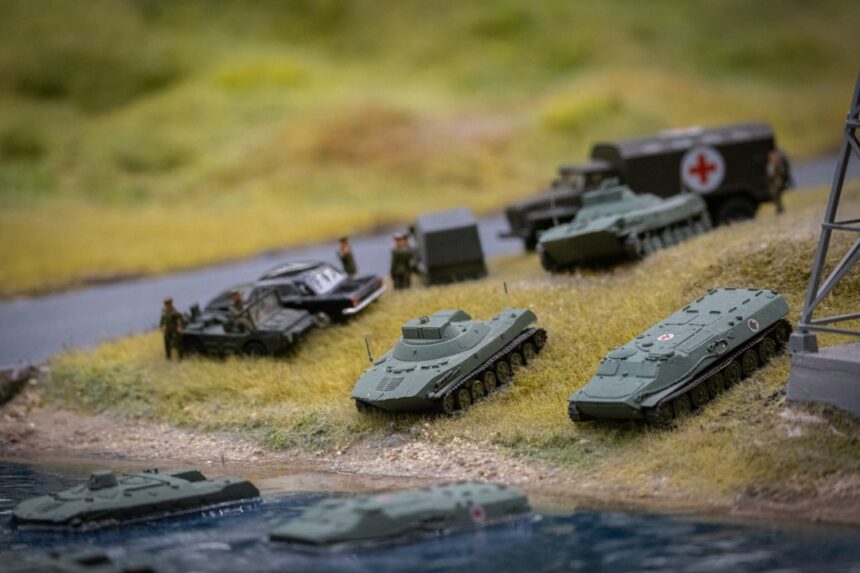In the realm of modern warfare, the concept of a “phantom army” has emerged as a significant and unsettling phenomenon. This term refers to the clandestine operations and unacknowledged military units that operate under the auspices of the Russian state. These forces, often shrouded in secrecy, have gained notoriety for their involvement in various conflicts, both within and beyond Russia’s borders.
The existence of such an army raises critical questions about the nature of contemporary warfare, state sovereignty, and the ethical implications of using unmarked troops in combat scenarios. The phantom army is not merely a figment of conspiracy theories; it represents a strategic approach that allows Russia to exert influence while maintaining plausible deniability. By employing these shadowy forces, the Russian government can engage in military operations without officially declaring war or mobilizing its regular armed forces.
This tactic has profound implications for international relations and security, as it blurs the lines between war and peace, complicating the responses of other nations.
Key Takeaways
- Russia’s Phantom Army is a covert military strategy that utilizes disinformation and deception to create the illusion of a larger and more powerful military force.
- The history of Russia’s Phantom Army dates back to the Soviet era, with the use of dummy tanks and aircraft to deceive enemy forces during World War II.
- The purpose of Russia’s Phantom Army is to intimidate and confuse adversaries, as well as to project an image of strength and capability on the global stage.
- Tactics and strategies of Russia’s Phantom Army include the use of fake news, social media manipulation, and the creation of false military exercises to mislead and distract opponents.
- The technology behind Russia’s Phantom Army includes advanced cyber capabilities, deepfake technology, and the use of unmanned aerial vehicles for reconnaissance and surveillance.
The History of Russia’s Phantom Army
The roots of Russia’s phantom army can be traced back to the Soviet era, where covert operations and proxy wars were commonplace. During the Cold War, the Soviet Union utilized various means to extend its influence globally, often employing unmarked troops or supporting insurgent groups in other nations. This historical precedent laid the groundwork for the modern incarnation of the phantom army, which has evolved in response to changing geopolitical landscapes.
In recent years, the phantom army has gained prominence through its involvement in conflicts such as the annexation of Crimea in 2014 and the ongoing war in Eastern Ukraine. During these events, unmarked soldiers, later identified as members of special forces or private military contractors, played pivotal roles in shaping the outcomes of these conflicts. The use of such forces allowed Russia to assert its interests while avoiding direct confrontation with NATO and other Western powers, showcasing a strategic evolution in military engagement.
The Purpose of Russia’s Phantom Army

The primary purpose of Russia’s phantom army is to project power while minimizing risk and accountability. By utilizing unacknowledged military units, Russia can engage in aggressive actions without facing immediate repercussions from the international community. This strategy enables the Kremlin to pursue its geopolitical objectives, such as territorial expansion or influence over neighboring states, while maintaining a veneer of legitimacy.
Moreover, the phantom army serves as a tool for hybrid warfare, blending conventional military tactics with unconventional methods such as disinformation campaigns and cyber operations. This multifaceted approach allows Russia to destabilize regions and undermine adversaries without resorting to traditional warfare. The ability to operate in the shadows provides Russia with a strategic advantage, complicating the responses of other nations and creating an environment of uncertainty.
Tactics and Strategies of Russia’s Phantom Army
| Tactic/Strategy | Description |
|---|---|
| Disinformation Campaigns | Spread false information to create confusion and sow discord. |
| Cyber Attacks | Targeting of critical infrastructure and government systems for disruption. |
| Hybrid Warfare | Combining conventional and unconventional tactics to achieve strategic goals. |
| Proxy Warfare | Supporting and directing proxy forces in conflicts to advance Russian interests. |
| Political Subversion | Undermining political systems and institutions through covert influence operations. |
The tactics employed by Russia’s phantom army are characterized by their adaptability and unpredictability. These forces often operate in small, mobile units that can quickly respond to changing situations on the ground. This flexibility allows them to engage in guerrilla warfare, ambushes, and other unconventional tactics that can catch opponents off guard.
Additionally, these units are often well-trained and equipped with advanced weaponry, enhancing their effectiveness in combat scenarios. Psychological operations also play a crucial role in the strategies of Russia’s phantom army. By leveraging disinformation and propaganda, these forces can manipulate public perception and sow discord among adversaries.
The combination of military prowess and psychological manipulation exemplifies the sophisticated nature of Russia’s approach to modern warfare.
The Technology Behind Russia’s Phantom Army
The technological capabilities of Russia’s phantom army are integral to its operational effectiveness. Advanced communication systems, surveillance technologies, and unmanned aerial vehicles (UAVs) enhance situational awareness and coordination among units. These tools enable rapid information sharing and decision-making, allowing phantom forces to execute complex operations with precision.
Moreover, cyber capabilities are a cornerstone of Russia’s military strategy. The integration of cyber warfare into conventional military operations allows for coordinated attacks on critical infrastructure and information systems. This dual approach not only disrupts enemy operations but also creates an environment of fear and uncertainty among adversaries.
As technology continues to evolve, so too will the methods employed by Russia’s phantom army, making it imperative for other nations to adapt their strategies accordingly.
The Global Impact of Russia’s Phantom Army

The emergence of Russia’s phantom army has far-reaching implications for global security dynamics. As these unacknowledged forces operate beyond traditional military frameworks, they challenge established norms regarding state sovereignty and international law. The use of phantom armies complicates conflict resolution efforts and raises questions about accountability for actions taken by these forces.
Furthermore, the activities of Russia’s phantom army have contributed to rising tensions between NATO and Russia. The presence of unmarked troops in conflict zones has led to increased military posturing on both sides, heightening the risk of miscalculation or escalation into direct confrontation. This environment fosters instability not only in Eastern Europe but also in other regions where Russian interests are at stake.
Uncovering the Truth About Russia’s Phantom Army
Despite the pervasive nature of Russia’s phantom army, uncovering the truth about its operations remains a formidable challenge. The Kremlin employs a range of tactics to obscure the activities of these forces, including disinformation campaigns aimed at discrediting independent investigations. Journalists and researchers often face significant obstacles when attempting to document the actions of phantom troops, as access to information is tightly controlled.
However, investigative efforts have shed light on some aspects of this shadowy force. Reports from various sources have revealed connections between unmarked soldiers and Russian special operations units or private military contractors like Wagner Group. These revelations have sparked debates about accountability and transparency within Russian military operations, highlighting the need for greater scrutiny from both domestic and international observers.
The Role of Disinformation in Russia’s Phantom Army
Disinformation is a critical component of Russia’s strategy concerning its phantom army. By disseminating false narratives and manipulating information, the Kremlin can shape public perception both domestically and internationally. This tactic serves multiple purposes: it obscures the true nature of military operations, undermines trust in opposing governments, and creates confusion among civilian populations.
The use of social media platforms has amplified the reach of disinformation campaigns, allowing for rapid dissemination of misleading information. These campaigns often target specific audiences with tailored messages designed to exploit existing divisions or fears. As a result, disinformation not only supports military objectives but also contributes to broader efforts to destabilize societies and weaken democratic institutions.
The Future of Russia’s Phantom Army
Looking ahead, the future of Russia’s phantom army appears poised for further evolution as geopolitical tensions continue to rise. The Kremlin is likely to refine its strategies and tactics in response to changing global dynamics and technological advancements. As other nations adapt their military capabilities to counter hybrid threats, Russia may seek new ways to leverage its phantom forces for strategic advantage.
Additionally, the increasing integration of artificial intelligence and autonomous systems into military operations could reshape the landscape in which phantom armies operate. These technologies may enhance operational efficiency while also raising ethical concerns regarding accountability and decision-making in combat scenarios. As such developments unfold, it will be crucial for policymakers and military leaders worldwide to remain vigilant and proactive in addressing the challenges posed by Russia’s phantom army.
International Response to Russia’s Phantom Army
The international community has begun to grapple with the implications of Russia’s phantom army through various diplomatic and military responses. NATO member states have increased their military readiness in Eastern Europe as a deterrent against potential aggression from unacknowledged Russian forces. Joint exercises and enhanced troop deployments signal a commitment to collective defense against hybrid threats.
Moreover, efforts to counter disinformation campaigns have gained traction among Western nations. Initiatives aimed at promoting media literacy and transparency seek to empower citizens against manipulation while fostering resilience against propaganda efforts. However, addressing the complexities posed by phantom armies requires a multifaceted approach that encompasses diplomatic engagement, economic sanctions, and strategic partnerships among like-minded nations.
Addressing the Threat of Russia’s Phantom Army
In conclusion, Russia’s phantom army represents a significant challenge in contemporary warfare that necessitates careful consideration from global leaders. The use of unacknowledged military forces complicates traditional notions of conflict and accountability while posing risks to international stability. As nations navigate this evolving landscape, it is essential to adopt comprehensive strategies that address both military readiness and information warfare.
Ultimately, confronting the threat posed by Russia’s phantom army will require collaboration among nations committed to upholding international norms and security principles. By fostering dialogue, enhancing transparency, and promoting resilience against disinformation, the global community can work towards mitigating the risks associated with this shadowy force while safeguarding democratic values and stability on a broader scale.
In exploring the intriguing narrative of “The Story of Russia’s Phantom Army,” one might find a related article that delves deeper into the strategic maneuvers and psychological tactics employed in modern warfare. A compelling read that complements this topic can be found on the website “In The War Room.” This platform offers a wealth of information on military strategies and historical analyses. For those interested in expanding their understanding of such military phenomena, I recommend checking out this related article that provides further insights into the complexities of warfare and the use of deception in military operations.
WATCH NOW! 🎖️ Plot Twist: Russia’s Military Is Being Eaten Alive By Its Own Corruption
FAQs
What is Russia’s phantom army?
Russia’s phantom army refers to the alleged use of fake military units and personnel by the Russian government to create the illusion of a larger military force than actually exists.
Why would Russia create a phantom army?
The creation of a phantom army could serve several purposes, including psychological warfare, deception, and the manipulation of public perception both domestically and internationally.
How has Russia utilized its phantom army?
There have been reports of Russia using its phantom army to create the appearance of a larger military presence during conflicts and geopolitical tensions, as well as to manipulate public opinion and sow confusion among adversaries.
What evidence exists to support the existence of Russia’s phantom army?
While there have been numerous reports and allegations regarding the use of a phantom army by Russia, concrete evidence is often difficult to obtain due to the secretive nature of such operations.
What are the implications of Russia’s phantom army for global security?
The existence of a phantom army raises concerns about the potential for misinformation and miscalculation in international relations, as well as the impact on military and strategic decision-making. It also highlights the evolving nature of modern warfare and the use of non-traditional tactics.




